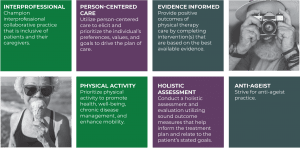APTA Geriatrics Sponsored Evidence Based Documents
- Home
- Evidence-Based docs
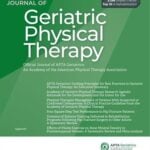
Guiding Principles for Best Practices in Geriatric Physical Therapy: An Executive Summary
Criss, Michelle G. ; Wingood, Mariana ; Staples, William H.; Southard, Veronica; Miller, Kenneth L.; Norris, Traci L.; Avers, Dale; Ciolek, Cathy H.; Lewis, Carole B. ; Strunk, Ellen R.
DetailsGuiding Principles for Best Practices in Geriatric Physical Therapy: An Executive Summary
Criss, Michelle G. ; Wingood, Mariana ; Staples, William H.; Southard, Veronica; Miller, Kenneth L.; Norris, Traci L.; Avers, Dale; Ciolek, Cathy H.; Lewis, Carole B. ; Strunk, Ellen R.
Details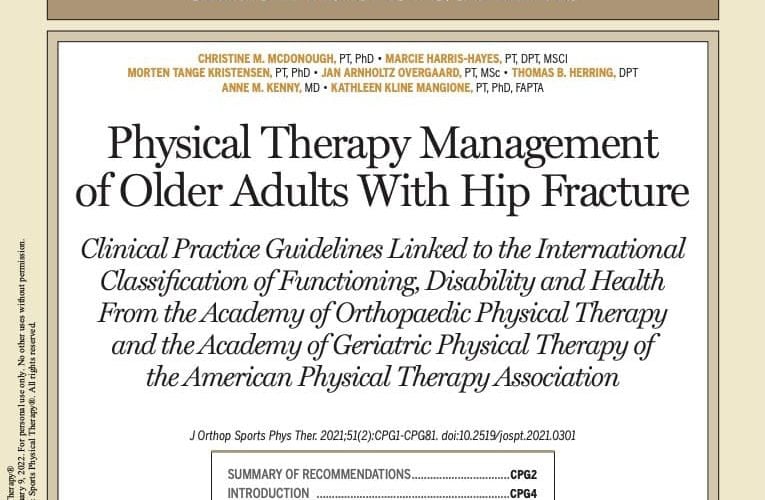
Physical Therapy Management of Older Adults with Hip Fracture
Christine M. McDonough, PT, PhD, Marcie Harris-Hayes, PT, DPT, MSCI, Morten Tange Kristensen, PT, PhD, Jan Arnholtz Overgaard, PT, MSc, Thomas B. Herring, DPT, Anne M. Kenny, MD, Kathleen Kline Mangione, PT, PhD, FAPTA
DetailsPhysical Therapy Management of Older Adults with Hip Fracture
Christine M. McDonough, PT, PhD, Marcie Harris-Hayes, PT, DPT, MSCI, Morten Tange Kristensen, PT, PhD, Jan Arnholtz Overgaard, PT, MSc, Thomas B. Herring, DPT, Anne M. Kenny, MD, Kathleen Kline Mangione, PT, PhD, FAPTA
Details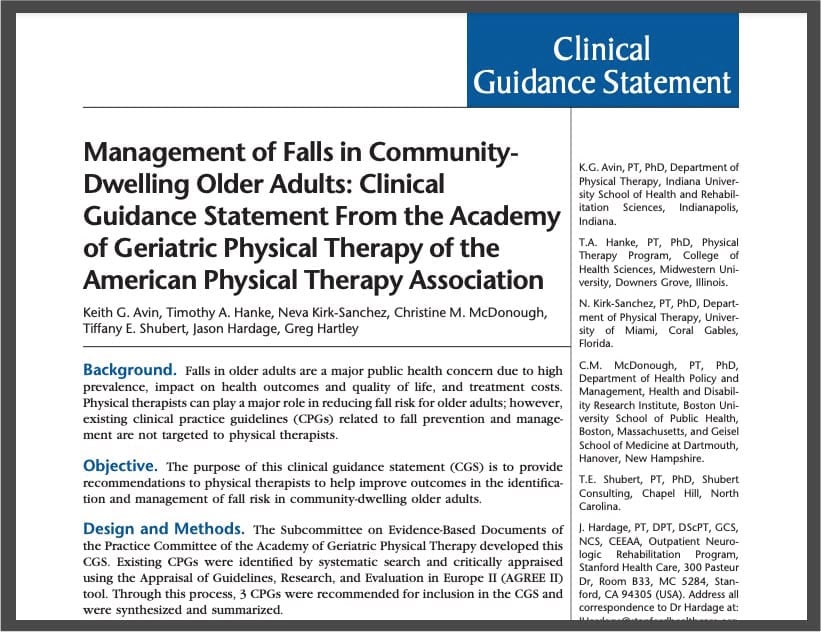
Management of Falls in Community- Dwelling Older Adults: Clinical Guidance Statement From the APTA Geriatrics of the American Physical Therapy Association
Keith G. Avin, Timothy A. Hanke, Neva Kirk-Sanchez, Christine M. McDonough, Tiffany E. Shubert, Jason Hardage, Greg Hartley
DetailsManagement of Falls in Community- Dwelling Older Adults: Clinical Guidance Statement From the APTA Geriatrics of the American Physical Therapy Association
Keith G. Avin, Timothy A. Hanke, Neva Kirk-Sanchez, Christine M. McDonough, Tiffany E. Shubert, Jason Hardage, Greg Hartley
Details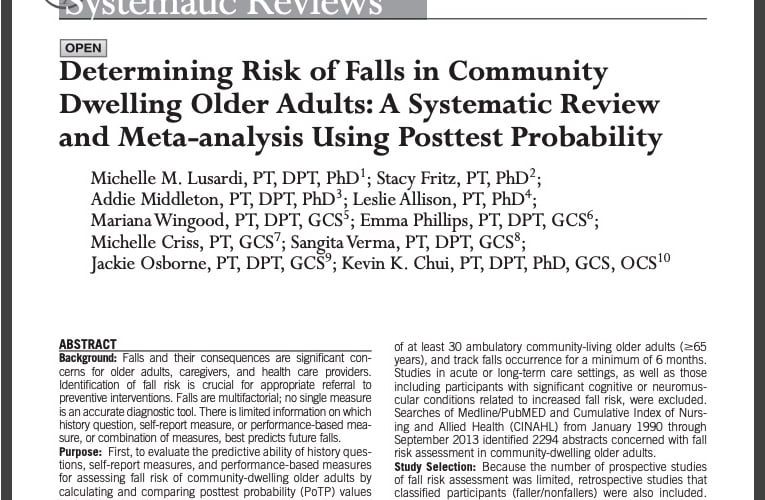
Determining Risk of Falls in Community Dwelling Older Adults: A Systematic Review and Meta-analysis Using Posttest Probability
Michelle M. Lusardi , PT, DPT, PhD 1 ; Stacy Fritz , PT, PhD 2 ; Addie Middleton , PT, DPT, PhD 3; Leslie Allison , PT, PhD 4; Mariana Wingood , PT, DPT, GCS 5 ; Emma Phillips , PT, DPT, GCS 6;
DetailsDetermining Risk of Falls in Community Dwelling Older Adults: A Systematic Review and Meta-analysis Using Posttest Probability
Michelle M. Lusardi , PT, DPT, PhD 1 ; Stacy Fritz , PT, PhD 2 ; Addie Middleton , PT, DPT, PhD 3; Leslie Allison , PT, PhD 4; Mariana Wingood , PT, DPT, GCS 5 ; Emma Phillips , PT, DPT, GCS 6;
Details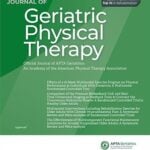
Physical Therapist Management of Patients With Suspected or Confirmed Osteoporosis
Hartley, Gregory W. PT, DPT, FAPTA1; Roach, Kathryn E. PT, PhD1; Nithman, Robert W. PT, DPT, PhD2; Betz, Sherri R. PT, DPT3; Lindsey, Carleen PT, MScAH4; Fuchs, Robyn K. PhD, FACSM5; Avin, Keith G. PT, DPT, PhD5
DetailsPhysical Therapist Management of Patients With Suspected or Confirmed Osteoporosis
Hartley, Gregory W. PT, DPT, FAPTA1; Roach, Kathryn E. PT, PhD1; Nithman, Robert W. PT, DPT, PhD2; Betz, Sherri R. PT, DPT3; Lindsey, Carleen PT, MScAH4; Fuchs, Robyn K. PhD, FACSM5; Avin, Keith G. PT, DPT, PhD5
DetailsAdditional Practice Information
- In alliance with the Academy’s Mission and Vision, the physical therapy care of older adults encompasses the entirety of the aging person within their unique environment and throughout their aging process. We believe the Physical Therapist/Physical Therapist Assistant (PT/PTA) must advocate to reduce health disparities and health care inequities, improve access to health care services, and address the health, wellness, and preventative health care needs of people.
- To that end, APTA Geriatrics presents the following guiding principles for Best Practices in providing geriatric physical therapy.
- Below are documents to help you implement an annual visit into your clinical practice. Additional background on annual visits can be found on the APTA website
- Instruction Manual for Annual Visits for Aging Adults
- Annual Visit for Aging Adult Intake Form
- Annual Visit for Aging Adult Form
- Annual Visit for Aging Adult Report Card
- Annual for Aging Adult Referral Form
- These recommendations are based on the best available scientific evidence and consensus from experts in their respective professions including the Centers for Disease Control and Prevention, the American College of Sports Medicine, the American Geriatrics Society, the American Heart Association, the American Cancer Society, and from the National Institutes of Health- the National Institute on Aging. These recommendations provide the framework for prescribing specific exercises by listing the key elements of exercise prescription (frequency, intensity, duration, volume). Physical therapists should use these recommendations as a starting place to design optimal and safe exercise programs. Download Here
Designed to help you identify discrepancies between your current and desired levels of practice in any of the seven specialty areas. Once you’ve assessed your practice level, you can map out your plan for continuing education and professional development. If you’re considering applying for specialist certification, use the Self-Assessment Tools to determine your readiness. Each self-assessment instrument includes suggestions for follow-up and development of an action plan. Help yourself with Self-Assessment Tools for Physical Therapists today!
- The Journal of Physical Therapy Education, Issue 2, 2014, is a special issue on education to improve practice for older adults. We are very pleased to share this issue with the members of the APTA Geriatrics. Visit Here
- A first-of-its-kind study shows that physical therapy and occupational therapy provide functional benefits to most patients in postacute care settings, with evidence of significant rehabilitative value across 1.4 million Medicare cases. This research used data that the Centers for Medicare & Medicaid Services made available for the first time. The findings have implications for postacute care payment system reforms and can serve as a baseline for future studies. Read more and download a summary and charts.
A Joint Report by the APTA Geriatrics Practice Committee (Greg Hartley, Chair), the Reimbursement/Legislative Affairs Committee (Ellen Strunk, Chair), and the GeriEDGE Task Force (Michelle Lusardi, Chair)
Outcome Measure Toolkit for Geriatric Fall/Balance Assessment
The Balance and Falls Special Interest Group of the APTA Geriatrics developed this toolkit as an updated summary of current outcome measures related to balance and fall risk assessment. It is available, OPEN ACCESS here:
Falls Prevention Awareness Toolkit: A Comprehensive Guide to Professional & Community Engagement, 2nd Edition
The Falls Prevention Awareness Toolkit developed by the Balance and Falls Special Interest Group of the APTA Geriatrics is available, OPEN ACCESS below.
The resources provided within the toolkit are designed to assist clinicians and students in creating and/or improving their community-based falls prevention events by utilizing current evidence and a wide-variety of quality resources.

